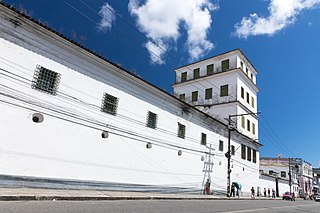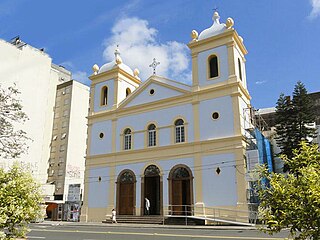
Chaves is a city and a municipality in the north of Portugal. It is 10 km south of the Spanish border and 22 km south of Verín (Spain). The population of the entire municipality in 2011 was 41,243, in an area of 591.23 km2. The municipality is the second most populous of the district of Vila Real. With origins in the Roman civitas Aquæ Flaviæ, Chaves has developed into a regional center. The urban area or city proper has 17,535 residents (2001).

Vila do Porto is the single municipality, the name of the main town and one of the civil parishes on the island of Santa Maria, in the Portuguese archipelago of Azores. Its nearest neighbor, administratively, is the municipality of Povoação on the southern coast of São Miguel, and it is physically southwest of the islets of the Formigas. The population in 2021 was 5,408, in an area of 96.89 km2 (37.41 sq mi).

Our Lady of Aparecida, is a title of the Blessed Virgin Mary associated with the Immaculate Conception.

The Church of Our Lady of Sorrows is a Roman Catholic church in Póvoa de Varzim, Portugal. It is located in Largo das Dores square, in the old town of Póvoa de Varzim, and is part of the parish of Matriz. The church is dedicated to Our Lady of Sorrows, Nossa Senhora das Dores in Portuguese.

Our Lady of Navigators also known as Our Lady of Seafarers is a devotional title given to the Virgin Mary by Roman Catholics. It is a widespread devotion in South America, especially in Brazil, where her holy day is celebrated on 2 February, it is an official holiday on the city of Porto Alegre. Several churches in Brazil are dedicated to Our Lady of Navigators.

The Sanctuary of Our Lady of Lapa and Residence of the Society of Jesus is a Christian sanctuary in the civil parish of Quintela, municipality of Sernancelhe of northern Portugal. The historical residence of the Society of Jesus, this site was transformed to support pilgrims to the site, and is marked by a chapel delineated by Corinthian columns, supporting plinths surmounted by simple frieze and cornice. The interior was decorated in azulejo tile of polychromatic vegetal design, with triumphal arch dividing the sanctuary from the college, identifiable by the large granite rock in its interior, where legend says the image of the Virgin Mary was first discovered. In this space is the oratory of Senhora das Dores with its nativity by António Ferreira. In the junction between presbytery and sacristy is the double-arched belfry. Also remarkable and unique for this site, and other buildings owned by the Society of Jesus, is the walkway that connects the residences of the complex with the church.

The Church of Our Lady of Brazil is a Catholic church in Nossa Senhora do Brasil Square, in the Brazilian city of São Paulo. The current building was constructed in 1942.

The Church and Convent of Our Lady of the Palm is a 17th-century Roman Catholic church in Salvador, Bahia, Brazil. The church is dedicated to Our Lady of the Palm and belongs to the Roman Catholic Archdiocese of São Salvador da Bahia. The church was established in 1830, and expanded to house members of the Order of Discalced Augustinians in Salvador and their missionaries from other Portuguese colonies. The church has a simple façade and a single bell tower. In contrast, the church has a richly decorated interior, with paintings, images, furniture, and religious implements from the 16th and 17th century. The Church and Convent of Our Lady of the Palm was listed as a historic structure by the National Institute of Historic and Artistic Heritage in 1938.

The Parish Church of Our Lady of Purification is an 18th-century Roman Catholic church located in Santo Amaro, Bahia, Brazil. The church is dedicated to Blessed Virgin Mary and belongs to the Roman Catholic Archdiocese of São Salvador da Bahia. Its construction is dated to 1706. The church was listed as a historic structure by the National Historic and Artistic Heritage Institute in 1958.

The Church of the Third Order of the Blessed Virgin Mary of Our Lady of the Conception of the Mulatto Brothers is an 18th-century Roman Catholic church and former convent in Salvador, Bahia, Brazil. The church was constructed in a neighborhood formerly occupied by mixed-race and Afro-Brazilian artisans. The exterior of the church has an elaborate roccoco pediment and towers; the interior of the church has a Baroque-style ceiling painting in the nave and neoclassical side altars and chancel. The name of the church, boqueirão, refers to a large slope and trench constructed between the high city and low city of Salvador; it served as a defense of the city against foreign invasion. It was listed as a historic structure by the National Historic and Artistic Heritage Institute in 1951.

The Royal and Venerable Confraternity of the Most Blessed Sacrament of Mafra, alternatively, the Royal and Venerable Brotherhood of the Most Blessed Sacrament of Mafra, is a public association of faithful of the Catholic Church, canonically established in the Basilica of Our Lady and Saint Anthony of Mafra, Portugal.

The Church and Convent of Our Lady of the Conception of Lapa (Portuguese: Igreja e Convento de Nossa Senhora da Conceição da Lapa is an 18th-century Roman Catholic church located in Salvador, Bahia, Brazil. The church is dedicated to Our Lady of the Conception and is part of the Roman Catholic Archdiocese of São Salvador da Bahia. It is known as key site in the Brazilian independence movement in the early 19th century. Sister Joana Angélica resisted the invasion of Portuguese troops into the convent and was killed by bayonet in 1822 at the south portal of the convent.

The Church of Our Lady of the Conception is a temple of the Catholic Church located on Independência Avenue, in front of the Dom Sebastião Square, in Porto Alegre, Brazil. It is one of the oldest churches in the city and the one that best preserves its original appearance, containing a rich internal decoration in gilded woodcarving and statuary, besides being a listed property by the City Hall.

The Minor Basilica of Our Lady of Sorrows is the oldest standing Catholic temple in the Brazilian city of Porto Alegre, in the state of Rio Grande do Sul. Its construction lasted a considerable time and the design of the facade, which was modified even before it was inaugurated, today features an eclectic style. However, the interior is richly decorated with gilded woodwork in a late Baroque style with neoclassical elements and has an important group of life-size Baroque statues of Christ representing the cycle of the Passion.

The Festival of Our Lady of Navigators is a traditional religious festival in the Brazilian city of Porto Alegre, paying homage to Our Lady of the Navigators. The culmination of the festivities takes place on February 2nd of each year. It is one of the largest religious festivities in the south of Brazil, and an Intangible Heritage of the city. Originally a Catholic festival, over time it absorbed many devotees of Iemanjá, creating a syncretic symbolism.
















